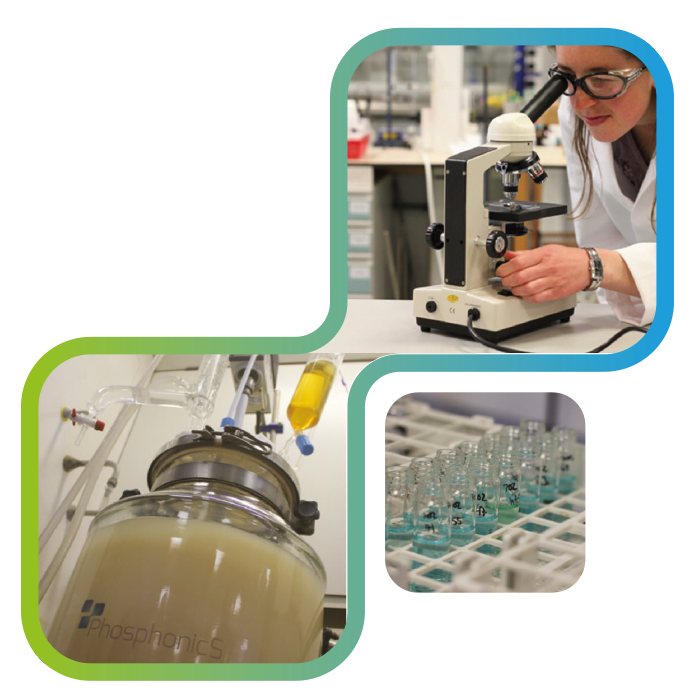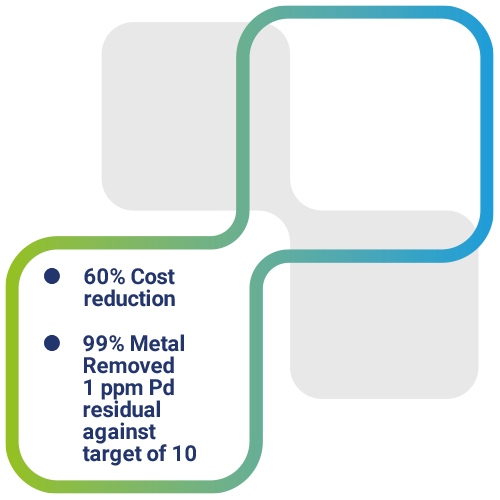PhosphonicS Advanced Scavenger Evaluation
Expert screening programme designed to help you develop a business case for investment
About PhASE – PhosphonicS Advanced Scavenger Evaluation
PhASE is a rigorous but flexible method to identify the best scavenger and then optimise a protocol for maximum efficiency in your processes. PhASE has been developed on the understanding that each process is unique, and the optimum recovery process will be different. PhASE has been developed to efficiently move from proof of concept to implementation in a flexible way to meet your requirements.
Benefits of the PhASE Process
- Identification of the best scavenger for your process
- A fit-for-purpose solution
- Full information set for business case and scale-up is clearly defined

The PhASE program

PhASE 1
- Scavenger library screening
![]()
- Optimal Scavenger

PhASE 2
- Thermodynamic profiles
- Kinetic profiles
![]()
- Parameter modelling for a plant-scale trial
- Initial commercial model

PhASE 3
- Confirmation of process conditions

PhASE 4
- Costs
- Return on investment
- Volumes
PhosphonicS Advanced Scavengers
Our collection of advanced scavengers is based on patented smart silica technology. We offer:
- Selective recovery of precious metals
- Highly porous silica for optimised stream flow
- Large surface area for higher loadings
- Stable in aqueous and organic media
- Temperature-resistant scavengers
- Easy to implement, scalable technology
- More than 8 years of continuous industrial application
- Produced on a multi-tonne scale

The PhASE process begins with sample assessment which includes the development and validation of a ICP method, as well as determining the nature of the stream (e.g. pH, viscosity, solids content, volatile components etc.).
| PhASE 1 |
PhASE 1 involves testing the stream against a selection of PhosphonicS scavengers based on prior experience and the specific application. Screening identifies the best scavenger for further study.
|
| PhASE 2 |
PhASE 2 involves isotherms to determine the favourability of the process (thermodynamics), providing the loading of metal on the scavenger (wt%) as well as the % recovery/removal, while kinetics determine the rate of removal.
|
| PhASE 3 |
PhASE 3 is a trial to confirm the performance of the scavenger based on the outputs of the engineering model. The trial can be in batch, semi continuous or continuous and can be carried out at a suitable lab or pilot scale to provide confidence in the performance.
|
| PhASE 4 | PhASE 4 is the detailed business case for implementation. See case studies for more information. |
Case Studies
Case Study 1: 90% value recovery of Pd catalyst
A pharmaceuticals manufacturer developed a route with a palladium-catalysed cross-coupling reaction. The final product was isolated with suitably low palladium levels, but the mother liquors contained 500 ppm palladium. The client was interested in the cost-effective recovery of the palladium from the stream to improve the sustainability of the process.
- Screening of the PhosphonicS scavenger library identified Phos-04 as the optimal scavenger.
- Optimisation process and lab-scale trial identified and validated the experimental conditions where 98% of the palladium was recovered from the mother liquors with 6% palladium loading on the Phos-04 scavenger. The recovery of 40 kg of palladium required 700 kg of Phos-04 scavenger.
- A business case was built upon the calculation that 96% of palladium was recovered from the liquors. After the scavenging and refining processes, this translated into 90% value recovery, dramatically reducing the effective cost of the palladium catalyst.

Case Study 2: Cost effective recovery of Rh from a continuous process waste stream
A chemicals manufacturer used rhodium as a catalyst to make a bulk chemical in a continuous process, which generated approximately 1 tonne of waste per day containing 200 ppm rhodium. Incineration and recovery of the contaminating metal recovered > 90% of rhodium but the cost of the refining made the process uneconomical.
- Screening of the PhosphonicS scavenger library identified Phos-05 as the optimal scavenger.
- Optimisation and lab scale trial identified and validated the experimental conditions that allowed recovery of 95% of rhodium from the waste with 3.5% rhodium loading on the Phos-05 scavenger.
- The business case was built upon the calculation that > 90% of rhodium could be recovered from the waste. After scavenger and refining costs, this translated into a 75% value recovery versus a net cost of the process.

Case Study 3: Optimised Pd removal from a pharmaceutical intermediate with 60% reduction in scavenger usage
A pharmaceutical client produced an intermediate using palladium catalysis which resulted in 1500 ppm Pd in the isolated product. Treatment of the product with the PhosphonicS product SEM26 removed the palladium to < 20 ppm using more than 100 wt% scavenger in batch slurry treatment. A PhASE program was carried out to optimise the scavenging process:
- Screening of the PhosphonicS scavenger library identified SPM32 and SEM26 as the optimal scavengers.
- Optimisation showed that increasing the treatment temperature from 40 to 60 °C resulted in a 60% reduction in treatment time with no compromise in product quality. The optimisation also showed that treatment in flow could reduce the scavenger by 60 – 90%. A column trial with a 1.5 h residence time reduced the Pd to less than 1 ppm in solution.
- In conclusion, the requirement of < 10 ppm Pd in the final product was met with reduced treatment time and reduced scavenger usage




